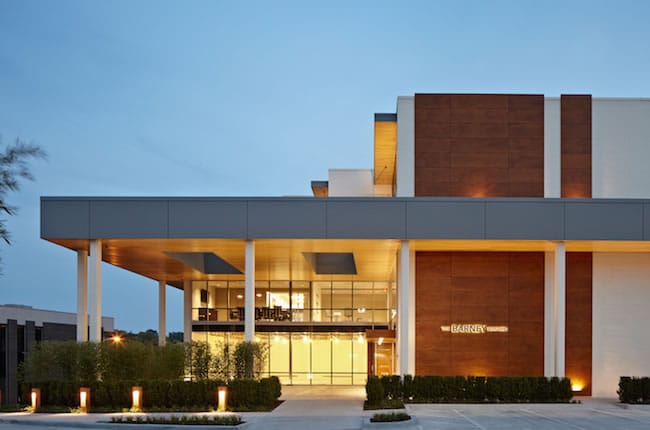Resting idly at an address that enjoys the company of heavy motor traffic and the heart of Kansas City’s nearby downtown shopping district, the aging mid-century office building at 2000 Shawnee Mission Parkway appeared to have been quietly giving its enviable inheritances to the wear of time when it was brought to the professional care of RMTA. Constructed in 1968, the structure has since housed a diverse range of tenants, most of which opted to decamp in recent years—chased away by an apparent lack of necessary upkeep and general maintenance.
This enduring neglect coupled with a drab, colorless exterior, seemed to ultimately demolish any chances of the building commanding the attention of the literal thousands of daily passersby. Typical of mid-century architecture, the windows were characterized by “small openings running vertically up the building,” as recalled by Mike Paxton, RMTA principal architect, offering the interior “little connection to the outside world,” as the building itself held little connection to the world immediately in front of it.

Wise to the potential commercial advantages still guarded by the space’s prime location and amply populated neighboring activity, Karbank Real Estate Company hopped aboard with the intention of saving a sinking ship, enlisting the services of RMTA, with whom they have maintained a longstanding business relationship of similar ventures. Residing in the same city as the desired property, Karbank knew the neighborhood and its inhabitants well enough to create “a new market niche,” as Paxton puts it, within its quarters. Suburban business executives in the Kansas City metropolitan area would enjoy the flavor of urban character at the comfort of suburban convenience.
PROJECT
LOCATION Mission Woods, Kansas
Program Complete office building renovation and addition
Size Four stories, 41,700 ft2 Completion 2014
Awards AIA Kansas Honor Award for Excellence in Architecture
Cost Withheld
TEAM
CLIENT Karbank Real Estate/ Steve Karbank
Architect RMTA
Contractor Jonkman Construction
Mechanical Consultant Bob D. Campbell and Co.
Plumbing Consultant BC Engineers, Inc.
Electrical Consultant M Panethiere & Associates Landscape Consultant Christopher Kusske Mechanical Engineer Design Mechanical
Electrical Engineer Pro Electric
Roofing Western Roofing Plumbing Central Plumbing Carpentry Firebaugh
SUPPLIERS
Rainscreen Prodema
Floor Tile Kansas Limestone
Bamboo Decking PlybooDex
Recycled Glass Countertops Vetrazzo
Microturbine Generators Capstone
Cork Rubber Flooring Zandur
Wall Tiles Porcelanosa and Royal Mosa
Kansas Limestone U.S. Stone Industries
Carpet Shaw Contract Group
Furniture Knoll, Herman Miller, Vitra
While the building was largely resigned to the faded background, concealed by its own lack of personality, there existed still certain qualities that RMTA found interesting whilst examining the premises. “The building had an interesting precast soffit running around it supported by free-standing columns,” Paxton notes, discovering that “this created a distinct look for the building and an interesting entry courtyard,” only, however, to be deafened by the colorless poverty of dreary off-white tones. This and other minor discoveries inspired the approach that would guide the parties tackling the project.
Karbank and the RMTA team agreed that while it was surely important to retain the historical qualities of the mid-century aesthetic, there were no shortage of overdue upgrades and makeovers competing for priority. Pointing the chisel to the weathered visage in a way that was respectful yet rehabilitative was the first objective. The character of the demographic-at-hand was also considered. A few of the recognizable traits that generally define an urban professional are well educated with a punctuated interest in style and a predilection for health and fitness, as well as a progressive moral conscience. It would be upon reviewing these considerations that an LED light bulb switched on in their minds.
While RMTA are surely seasoned professionals at honing their craft in ways that balance environmental consciousness with stylistic excellence, their client was not just enthusiastic about the attractive prospects of sustainability as a selling point to responsible professionals but confident too that elevating the objective to achieving LEED certification was a possibility within reach for the acquired space, given the foreseeable feasibility of much of its restoration and recovery. Green ethics were considered all the way down to whence product materials were collated, half of which—including the limestone floor tiles—were retrieved regionally. Occupancy sensors govern the LED lighting that illuminates the revamped dwellings only as need be. The exterior window system, once narrow and restricting and now vast and inviting, welcomes in natural daylight in sizable quantities. Furnished with Capstone MicroTurbine generators, natural gas powers the haunt without taking any environmental casualties.
RMTA project manager Kyle Patneau reflects proudly, “Our client’s unwillingness to compromise good design was what made this project successful.” And it is true that, once a project is given the “green light,” it is not just an individual devotion to energy efficient building standards that thrive but a contagious sentiment to others as well. Third parties involved marched to the LEED beat quite readily. “The general contractor really got on board with the LEED concept,” recounts Paxton, “and was extremely diligent in their recycling of the existing building materials, as well as minimizing construction waste.”
While attaining LEED certification status was in the cards from the very beginning, discussions hadn’t touched upon which rung on the ladder they’d ultimately grasp—merely achieving a certification of any kind was a commendable enough back-patter. “The building is anticipated to achieve LEED Gold,” Paxton divulges. It was a feat unexpected but, according to Patneau, after crunching the numbers at the last minute they discovered they applied. What a very pleasant surprise.

The rainchains standout as a favorite element of the project, as they function as both a piece of sculpture and a vehicle to carry rainwater, giving off a unique connection between the building and nature.


The building’s exterior window system was once narrow and restricting but now welcomes in natural daylight in sizable quantities.

